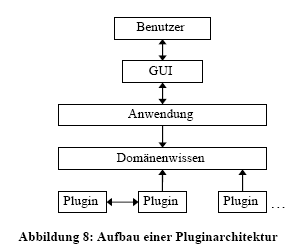
3 configuration options of software
Plugin architectures are far common and since 1987 admits103, because each device driver is also a Plugin.
Prominent examples are the Adobe of products, all possible Plugins for Browser like the Java, the Flash or the Realplayer Plugin
and the developer platform Eclipse as well as the VDR software used here.
Plugins are thereby functionally independent additions of an application, which cover a technical function completely,
without other components would have to be informed.
The application is
responsible for the interfaces. Plugins are thereby more independent components than components. Besides they are written
exclusively for an application and must into an existing system be integrated, work This also only with its application
data.
Plugins are optional differently as components so actually than
understanding and extend a software already functioning by certain functions or function groups. Plugins are latched
thereby into the existing system and contain their own configuration.
They cannot be used however without integrative application. The main difference to components lies however in the emergence.
Component architectures arranged an application into the computation logic and the infrastructure, This the technical interests,
here apply: Logic and containers are separated. Plugins against it arranged entire application into same functional ingates and
"put them again into one another ", therefore the name Plugins, here apply: Applications are separated by Plugins.
Their application can remain invisible as in the Browserbeispiel for the user, if this downloads
and installs a Plugin independently; in the Adobebeispiel each Plugin reserves itself a range in the menu.
By their structure innovative ideas are possible, for Eclipse so e.g. offer Plugins for code generators,
Datenbankbrowser, Wikis etc.
Plugins can cause themselves
and give also mutually at the installation time on. With the installation the Plugins must register itself
with application, in order to be able to use their functions. The structure of a Pluginhierarchie can be
represented as follows: 104

| Evaluation of Plugin architectures105 |
| Advantages | Disadvantages |
|
Top| Home| << back | next >> >> Home Page www.unitec.it << |